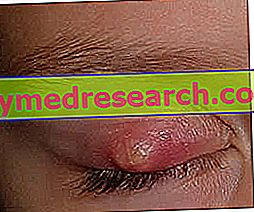Calazio: what is it?
Calazio is a chronic inflammation of the meibomian sebaceous glands located along the entire thickness of the lower and upper eyelids. Typical of blepharitis, seborrhea and acne rosacea, calazi are easily distinguished from other ocular pathologies by the formation of a cystic lesion in correspondence with the gland involved in the infection.
When inflammation affects more than one meibomian gland, one speaks precisely of calaziosi.
Curiosity
The chalazion is also known with the expression of Meibomian cysts, just to indicate the target of the infection (glands of Meibomio) and the typical nodule that distinguishes it (cyst).
Causes

The meibomian glands (also called tarsal glands) are small secretory organs responsible for the production of lacrimal sebum.
The secretion produced by these glands is essential for:
- Preserve corneal hydration
- Impede the evaporation of the tear film
- Promote the sliding of the eyelids on the eye
The closing of the excretory duct of one or more of these glands favors the retention of the pus inside them: the secreted product, in fact, not finding an escape route to the outside, accumulates exaggeratedly inside the glandular duct until giving origin to a small nodule (granuloma) very similar to a cyst.
Of course, the growth of chalazion is related to an inflammatory process: what the experts have not yet been able to explain is why the meibomian glands undergo this blockage. Some hypotheses have been formulated based essentially on the observation and analysis of signs, symptoms and related diseases of patients suffering from chalazion. The characteristic cyst has been repeatedly analyzed in individuals suffering from acne rosacea, stye, blepharitis (inflammation of the eyelid) and other skin diseases such as eczema. Starting from these observations, the researchers are convinced that chalazion is closely linked to the co-presence of similar disorders.
In the past it was believed that chalazion had a purely infectious origin; today, however, this supposition has been discarded, although some scholars believe that a preexisting eye infection may somehow accentuate the symptoms of chalazion.
Cysts and symptoms
To learn more: Symptoms Calazio
In a sense, the presence of a small solid cyst along the eyelid margin constitutes the digital imprint of the chalazion, the only appreciable sign that allows to recognize the disorder unequivocally.
The chalazion characteristic cyst has an almost always benign nature: the possibility that the cyst hides a carcinogenic lesion is an extremely rare event.
Most of the time, patients affected by chalazion do not experience significant symptoms: rather than pain, the cyst can cause an unpleasant sensation of palpebral weighting, especially when the chalazion reaches considerable size. The possible presence of pain, redness and hyperlacrimation that accompanies calazum finds the most probable explanation in a bacterial or, less often, viral insult.
When it depends on blepharitis, the chalazion can form small crusts between the eyelashes, to the point of causing itching on the eyelid edges and burning.
The main problem caused by the chalazion is of an aesthetic nature because, growing right along the eyelid margin, it removes its natural expression and its charm from the eye.
Treatment
Although some cases of spontaneous resolution have been reported, the most indicated treatment to completely remove the chalazion is surgery. When necessary, surgery can be supported by a topical therapy consisting of the application of ophthalmic ointments / cortisone drops (for inflammation) and / or antibiotic drugs to fight or prevent an eventual infection.
To learn more: Medications for the Treatment of Chalazion »
Some patients with chalazion, however, recover by simply applying specific drugs directly into the eye, without resorting to surgery.
What is the intervention?
The surgery to remove the chalazion is quite simple. Before proceeding, the patient will have to sign a form declaring to have been informed about the purpose, methods and possible risks of the intervention, giving his consent to the surgical execution.
At this point, you can proceed with the operation:
- The eyelid involved in the chalazion is anesthetized (local anesthesia with a lidocaine injection)
- The doctor proceeds with the incision of the eyelid tissue
- Subsequently, the inflamed cyst is removed and the inflamed gland is adequately cleaned
- The small incision is closed with a few stitches
- The eye is blindfolded for a few hours
What happens after the surgery?
During the post-operative hours, it is not uncommon for the patient to experience symptoms such as edema (palpebral swelling), burning, pain, discomfort and the sensation of a foreign body in the eye.
After a few days of surgery, the patient will have to go back to the clinic to remove the stitches. To reduce eyelid swelling, the doctor generally prescribes specific eye drops.
What are the complications?
Since it is a surgical procedure, even the removal of the chalazion can cause complications such as eyelid bleeding, scarring and permanent eyelid lesions. The risks just listed, however, are rather infrequent, and always linked to the (in) experience of the doctor. For this reason, it is recommended to contact specialists, even for simple interventions such as chalazion removal.
However, regardless of the way in which the cyst has been removed, the patient may experience recurrences because the excision procedure is not always definitive and the meibomian glands can become inflamed again, thus causing the birth of new calazi.



